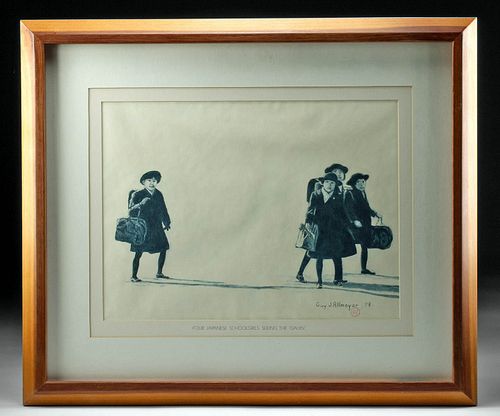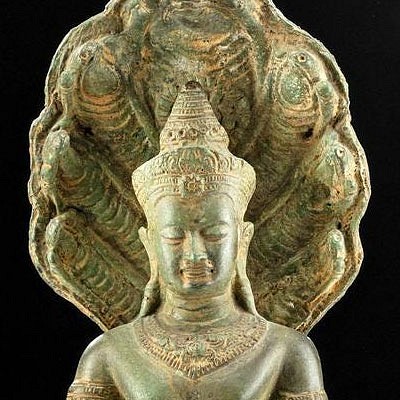Framed Allmeyer Print, Japanese School Girls See Gaijin
Lot 27
About Seller
Artemis Fine Arts
686 S Taylor Ave, Ste 106
Louisville, CO 80027
United States
Selling antiquities, ancient and ethnographic art online since 1993, Artemis Gallery specializes in Classical Antiquities (Egyptian, Greek, Roman, Near Eastern), Asian, Pre-Columbian, African / Tribal / Oceanographic art. Our extensive inventory includes pottery, stone, metal, wood, glass and textil...Read more
Categories
Estimate:
$600 - $900
Absentee vs Live bid
Two ways to bid:
- Leave a max absentee bid and the platform will bid on your behalf up to your maximum bid during the live auction.
- Bid live during the auction and your bids will be submitted real-time to the auctioneer.
Bid Increments
| Price | Bid Increment |
|---|---|
| $0 | $25 |
| $300 | $50 |
| $1,000 | $100 |
| $2,000 | $250 |
| $5,000 | $500 |
| $10,000 | $1,000 |
| $20,000 | $2,500 |
| $50,000 | $5,000 |
| $100,000 | $10,000 |
| $200,000 | $20,000 |
About Auction
By Artemis Fine Arts
Aug 10, 2021
Set Reminder
2021-08-10 12:00:00
2021-08-10 12:00:00
America/New_York
Bidsquare
Bidsquare : Museum-Deaccession | Asian & Pre-Columbian
https://www.bidsquare.com/auctions/artemis-gallery/museum-deaccession-asian-pre-columbian-7316
An interesting mix of de-accessioned Asian and Pre-Columbian Art from The Ashland University Museum in Ashland, OH, originally donated between 1994 to 1998. All lots from the Museum have been noted, as such. Artemis Fine Arts info@artemisgallery.com
An interesting mix of de-accessioned Asian and Pre-Columbian Art from The Ashland University Museum in Ashland, OH, originally donated between 1994 to 1998. All lots from the Museum have been noted, as such. Artemis Fine Arts info@artemisgallery.com
- Lot Description
Guy John Allmeyer (American, 20th century). "Four Japanese School Girls Seeing the 'Gaijin'" print, 1978. Signed and dated on the lower right. A nicely framed composition depicting four Japanese school girls as they respond to a 'gaijin' sighting on their way to or from school. Note the girls' curious expressions of culture shock as the they come upon this unfamiliar visitor. 'Gaijin' is a Japanese word for foreigners of non-Asian ethnicity. Since the term is sometimes considered derogatory, the more neutral term 'gaikokujin' is oftentimes used instead. This said, the term is still used in popular culture - most recently as the title of Fumi Inoue's animation short "Gaijin" (2003). Allmeyer's piece is complemented beautifully with a double matte and a custom wooden frame. Size of composition: 13.25" L x 17" W (33.7 cm x 43.2 cm) Size of frame: 22.25" L x 26.25" W (56.5 cm x 66.7 cm)
Provenance: private Evergreen, Colorado, USA collection; ex-private Denver, Colorado, USA, collection, acquired 1960 to 2000
All items legal to buy/sell under U.S. Statute covering cultural patrimony Code 2600, CHAPTER 14, and are guaranteed to be as described or your money back.
A Certificate of Authenticity will accompany all winning bids.
PLEASE NOTE: Due to recent increases of shipments being seized by Australian & German customs (even for items with pre-UNESCO provenance), we will no longer ship most antiquities and ancient Chinese art to Australia & Germany. For categories of items that are acceptable to ship to Australia or Germany, please contact us directly or work with your local customs brokerage firm.
Display stands not described as included/custom in the item description are for photography purposes only and will not be included with the item upon shipping.
#166304The work has not been examined outside the frame but appears to be in very nice condition. It is signed and dated on the lower right. The title appears on the custom matte as well. Title, date, and artist's name are handwritten on the verso, possibly by the artist. The artist's card is attached to the verso as well.Condition
- Shipping Info
-
All shipping is handled in-house for your convenience. Your invoice from Artemis Gallery will include shipping calculation instructions. If in doubt, please inquire BEFORE bidding for estimated shipping costs for individual items.
-
- Buyer's Premium



 EUR
EUR CAD
CAD AUD
AUD GBP
GBP MXN
MXN HKD
HKD CNY
CNY MYR
MYR SEK
SEK SGD
SGD CHF
CHF THB
THB













